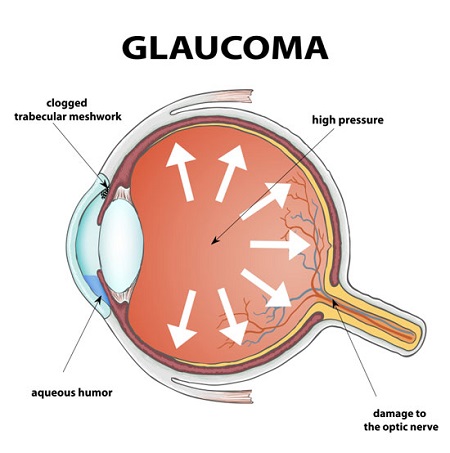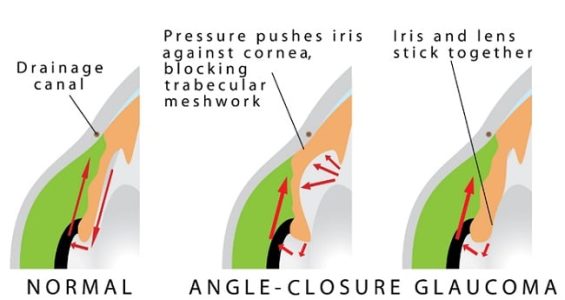Glaucoma is an eye condition caused by damage to the optic nerve, often resulting from increased pressure in the eyes. As it nearly has no symptoms in the early stages and can lead to loss of vision if not diagnosed and treated early, glaucoma takes away sight from millions of people worldwide each year.

GLAUCOMA TREATMENT
- This is to help prevent further damage to the optic nerve and maintain vision for as long as possible. Treatment depends on the type and stage of the disease.
- Medication; medication is prescribed to reduce eye pressure so that optic nerve does not become further damaged
- Laser eye surgery; the type of laser used depends on the type and stage of the glaucoma
- Eye surgery; this is generally the route taken to treat patients whose intraocular pressure cannot be controlled by medication or laser eye surgery
GLAUCOMA PREVENTION
Unfortunately, there is currently no way to completely prevent it; however, vision loss can be prevented with early diagnosis and treatment.
People are advised to:
- Have regular eye examinations; those over 40 should have their eyes examined yearly
- Be careful not to injure the eyes; keep them protected
- Studies have shown that moderate exercise, such as walking or jogging 3 or more times a week helps reduce the risk of high intraocular pressure
THE MECHANISM OF GLAUCOMA
- The front part of the eye is filled with a clear fluid called intraocular fluid (aqueous humor), made by the ciliary body. The fluid flows out through the pupil into the anterior chamber, and then to drains out of the eye via the trabecular meshwork (a meshwork of drainage canals around the outer edge of the iris). In the case of glaucoma, the eye’s drainage system becomes clogged. As the fluid builds up, it causes pressure to build within the eye. This high pressure damages the optic nerve.


EYE PRESSURE AND GLAUCOMA
- Eye pressure is the fluid pressure inside the eye. Normal eye pressure ranges from 5-22 mmHg. Eye pressure of greater than 22 mm HG is considered abnormally high. Eye pressure is an important risk factor for developing glaucoma.
RISK FACTORS FOR DEVELOPING GLAUCOMA
- People of African descent are 6-8 times more susceptible to glaucoma than people of Caucasian descent, while people of Asian descent are at higher risk of angle-closure glaucoma.
- Being 40 years of age or older
- Having a family history of glaucoma
- Having high eye pressure
- Having had an eye injury
- Taking steroid medications
- Other risk factors include a high degree of near and far sightedness, thin cornea, diabetes, and migraines.
TYPES OF GLAUCOMA
- Primary open angle glaucoma: This is the most common type of glaucoma. It occurs when the trabecular meshwork becomes clogged. As the fluid builds up, it causes pressure to build within the eye. High pressure damages the optic nerve.

- Symptoms: Most patients do not have any symptoms in the early stages of the condition. However, if it is not treated early, gradual loss of sight starting with peripheral vision will occur – before finally resulting in permanent vision loss. In most cases of primary open angle glaucoma, medications can control the condition if it is diagnosed and treated in its early stage.

- Normal-tension glaucoma: Some patients develop glaucoma with eye pressure below 22 mmHg. Important risk factors include:
- A family history of normal-tension glaucoma
- Being of Japanese descent
- Having a personal history of cardiovascular disease, hemodynamic crisis, low blood pressure at night, abnormal blood coagulation, migraines, or immune factors

Symptoms: In angle-closure glaucoma, the symptoms vary:
- Acute angle-closure glaucoma: This is a considered a medical emergency due to the sudden extreme increase in eye pressure. Symptoms include severe headache and eye pain, eye redness, watery eyes, sensitivity to light, blurred vision, halos around lights, nausea and vomiting.
- Sub-acute angle-closure glaucoma: Symptoms are mild and intermittent. Patients may only have a headache. It is difficult to diagnose this form of glaucoma without an eye screening.
- Chronic acute angle-closure glaucoma: Patients usually have no symptoms in the early stage of this form of glaucoma, as it develops very slowly.
- Congenital glaucoma: This form of glaucoma is already present in babies and children, as it can be inherited. While it is rare, the symptoms are severe and hard to be controlled. Permanent vision loss occurs if it is not treated in its early stage.
- Secondary glaucoma: This type of glaucoma is caused by an eye disease or underlying medical condition, including an eye injury, eye inflammation, eye tumor, advanced cataract, diabetes, and the use of certain medications such as steroids. Treatments vary, depending on the cause of the high eye pressure.
- Glaucoma suspect: In some cases, patients have an optic nerve or visual field that looks suspicious for glaucoma, requiring regular medical attention.
DIAGNOSIS INCLUDES
- Slit-lamp Microscopy Eye Exam
- Eye Pressure Test (Intraocular Pressure)
- Anterior Chamber Angle Exam
- Optic Nerve Exam
- Visual Field Test
